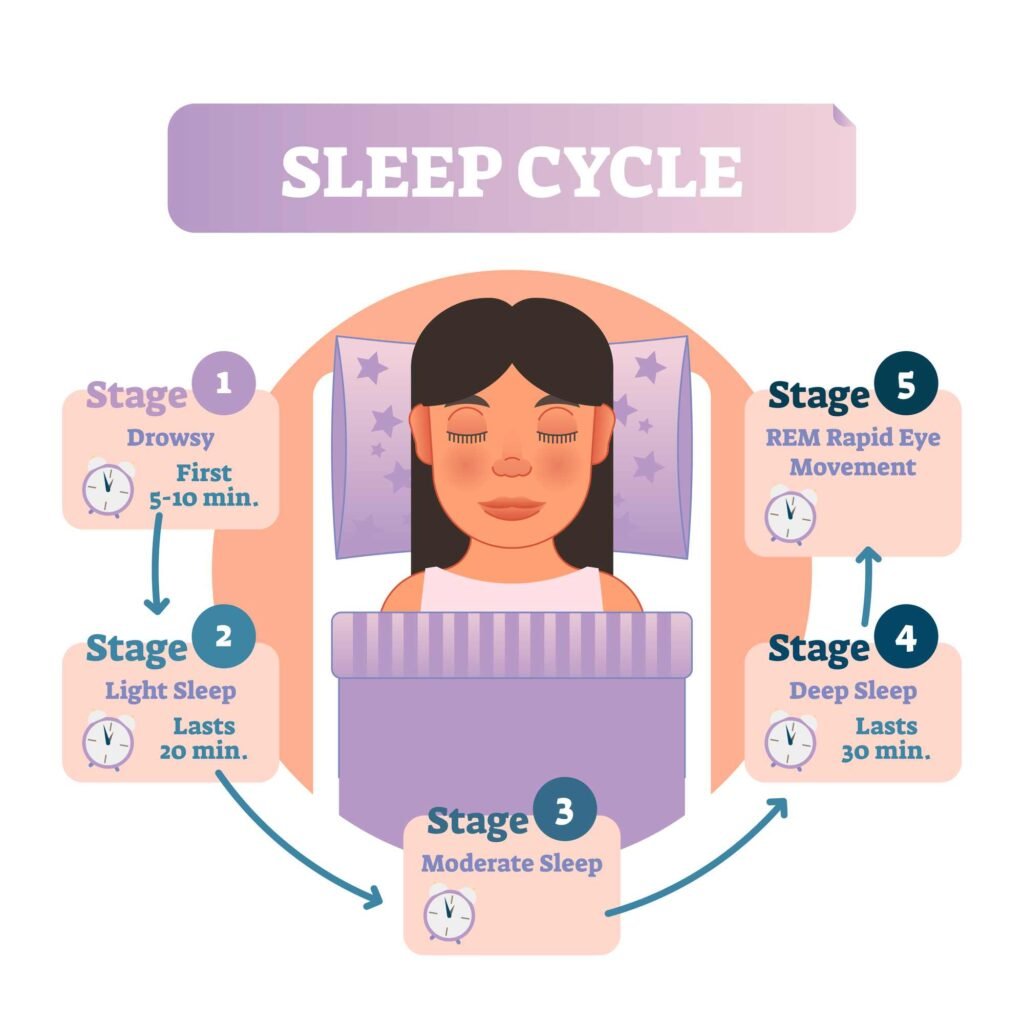Rapid Eye Movement is a stage of sleep that is characterized by quick and random eye movements, increased brain activity, and vivid dreams.
Rapid Eye Movement (REM) is one of the five stages of sleep that occur in a cyclical pattern throughout the night. REM sleep typically occurs every 90 minutes and lasts for about 20-25% of a person’s total sleep time.
During REM sleep, the body experiences a state of paralysis, which prevents the individual from acting out their dreams. This stage of sleep is essential for cognitive functioning, memory consolidation, and emotional regulation. Research has also shown that REM sleep plays a crucial role in learning and creativity. Additionally, REM sleep has been linked to various health benefits, including improved mood, decreased stress levels, and enhanced immune function.
Understanding the importance of REM sleep is crucial for maintaining overall health and well-being. In the following article, we will explore the science behind REM sleep, its functions, and the potential consequences of sleep deprivation on REM sleep.

Fundamentals of REM Sleep
Defining REM Sleep
Rapid Eye Movement (REM) sleep is a stage of sleep where the eyes move rapidly from side to side, and the brain activity is similar to that of being awake. During REM sleep, the body is in a state of paralysis, which prevents the individual from acting out their dreams. It is a crucial stage of sleep that plays a significant role in memory consolidation, emotional regulation, and overall cognitive functioning.
Stages of Sleep
Sleep is divided into two main categories: Rapid Eye Movement (REM) sleep and Non-Rapid Eye Movement (NREM) sleep. NREM sleep is further divided into four stages, with each stage having its unique characteristics.
During stage 1, the individual is in a light sleep state and can easily be awakened.
In stage 2, the body temperature drops, and the heart rate slows down.
Stage 3 is known as deep sleep, and it is challenging to wake up the individual during this stage.
Finally, stage 4 is the deepest stage of sleep, and it is the most restorative stage.
REM sleep typically occurs 90 minutes after falling asleep and recurs every 90 minutes throughout the night. The first REM cycle is usually short, lasting only a few minutes, but it gradually increases in duration with each cycle. The average adult spends approximately 20% of their sleep time in REM sleep.
Conclusion
In conclusion, Rapid Eye Movement sleep is a vital stage of sleep that plays a crucial role in overall cognitive functioning. It is characterized by rapid eye movements, paralysis of the body, and brain activity similar to that of being awake. Understanding the fundamentals of REM sleep is essential in maintaining good sleep hygiene and overall health.
Physiological Characteristics
Brain Activity During REM
During Rapid Eye Movement (REM) sleep, the brain exhibits characteristics that distinguish it from other stages of sleep. The electroencephalogram (EEG) recording during REM sleep shows high-frequency, low-amplitude brain waves that are similar to those observed during wakefulness. The brain activity is most prominent in the pons, a region of the brainstem that is responsible for the regulation of sleep and arousal. The pons sends signals to the thalamus, hypothalamus, and cortex, which are involved in the regulation of sensory perception, hormone secretion, and consciousness.
Eye Movements and Muscle Atonia
One of the most noticeable characteristics of REM sleep is the rapid movement of the eyes. The eyes move back and forth quickly, hence the name Rapid Eye Movement. The eye movements are controlled by the pontine tegmentum, which is located in the brainstem. During REM sleep, the muscles of the body, except for the muscles that control eye movement and respiration, become atonic or paralyzed. This state of muscle atonia is believed to prevent the body from acting out the dreams that occur during REM sleep.
Heart Rate and Breathing
The autonomic nervous system, which regulates heart rate and breathing, is also affected during REM sleep. The heart rate and breathing become irregular and may fluctuate in response to the content of the dream. The locus coeruleus, a region of the brainstem that is involved in the regulation of arousal and stress, is responsible for the changes in heart rate and breathing during REM sleep.
In conclusion, Rapid Eye Movement (REM) sleep is characterized by distinct physiological characteristics that are different from other stages of sleep. These characteristics include high-frequency, low-amplitude brain waves, rapid eye movements, muscle atonia, and irregular heart rate and breathing. The brain regions involved in the regulation of sleep and arousal, such as the pons, thalamus, hypothalamus, and cortex, play a crucial role in the generation and maintenance of REM sleep.
REM Sleep and Dreaming
Nature of Dreams
During REM sleep, the brain is highly active and can produce vivid and complex dreams. Dreams during REM sleep are characterized by a fast-paced narrative, intense emotions, and sensory experiences that can feel as real as waking life. While the content of dreams can vary widely, common themes include flying, falling, being chased, and experiencing intense emotions such as fear or joy.
Connection to Memory and Learning
Research suggests that REM sleep plays a crucial role in memory consolidation and learning. During REM sleep, the brain processes and consolidates memories from the previous day, enhancing long-term retention. This process is thought to occur through the strengthening of neural connections, particularly in regions of the brain involved in memory and learning.
Emotional processing also appears to be a key function of REM sleep. Studies have shown that emotional experiences are more likely to be incorporated into dreams during REM sleep, and that this process may help to regulate emotions and reduce the impact of negative experiences on mental health.
Lucid dreams, in which the dreamer is aware that they are dreaming and can often control the dream narrative, also occur during REM sleep. While the exact mechanisms behind lucid dreaming are not fully understood, it is thought to involve increased activity in the prefrontal cortex, which is responsible for self-awareness and decision-making.
Overall, REM sleep and dreaming play a critical role in brain function and have important implications for memory, learning, and emotional processing.
Developmental and Evolutionary Perspectives
REM Sleep in Infants and Mammals
Rapid Eye Movement sleep is a prominent feature of the sleep cycle in mammals, including humans. Studies have shown that infants spend a significant amount of time in REM sleep, which is believed to play a crucial role in their brain development. During REM sleep, the brain is highly active, and the body is almost completely paralyzed, except for eye movements and occasional twitches.
Research has suggested that the amount of REM sleep in infants is related to brain development. Infants who spend more time in REM sleep tend to have more advanced cognitive and motor development. Furthermore, studies have shown that REM sleep deprivation in infant animals can lead to developmental delays and behavioral abnormalities.
Birds, Reptiles, and the Platypus
While REM sleep is a well-known phenomenon in mammals, it is less clear whether other animals experience this type of sleep. However, recent studies have suggested that birds, reptiles, and the platypus also exhibit REM sleep.
Birds, for example, show similar patterns of brain activity during sleep as mammals do during REM sleep. Reptiles, on the other hand, have been observed to have a similar sleep cycle to mammals, including periods of deep sleep and REM sleep. The platypus, a unique mammal that lays eggs, also shows signs of REM sleep.
Overall, these findings suggest that REM sleep may have evolved early in the history of vertebrates and may play an important role in brain function and development across a wide range of species.
Health and REM Sleep
Sleep Disorders Involving REM
Rapid Eye Movement sleep is important for overall health and well-being. However, certain sleep disorders can disrupt REM sleep, leading to negative health consequences. One such disorder is REM sleep behavior disorder (RBD), which is characterized by the loss of muscle atonia during REM sleep, resulting in physical movement and potentially harmful behavior during sleep. RBD is associated with an increased risk of developing neurodegenerative disorders such as Parkinson’s disease.
Narcolepsy is another sleep disorder involving REM sleep. People with narcolepsy experience excessive daytime sleepiness and may have sudden episodes of falling asleep during the day. They also experience a phenomenon known as sleep paralysis, where they are unable to move or speak while falling asleep or waking up. Narcolepsy is thought to be caused by a deficiency in the neurotransmitter hypocretin, which regulates sleep and wakefulness.
Impact of Lifestyle and Substances
Lifestyle factors and substances can also impact REM sleep. Obstructive sleep apnea (OSA), a sleep disorder where breathing is repeatedly disrupted during sleep, can lead to fragmented sleep and reduced REM sleep. Sleep disruption from obstructive sleep apnea has been linked to an increased risk of cardiovascular disease, stroke, and other health conditions.
Alcohol consumption can also disrupt REM sleep, leading to a decrease in overall sleep quality. People who smoke or use certain drugs, such as cocaine and amphetamines, may also experience disrupted REM sleep. Additionally, some antidepressants and stimulants can interfere with REM sleep, leading to negative health consequences.
Overall, maintaining healthy sleep habits and avoiding substances that can disrupt REM sleep is important for overall health and well-being.
Treatment and Management
Approaches to REM Sleep Disorders
There are several approaches to treating REM sleep disorders, including medication, therapy, and lifestyle changes. Medications such as clonazepam, melatonin, and antidepressants have been shown to be effective in reducing the symptoms of REM sleep behavior disorder (RBD) and cataplexy. Therapy, such as cognitive-behavioral therapy (CBT), can also be helpful in managing RBD and excessive daytime sleepiness.
In addition to medication and therapy, there are several lifestyle changes that can help manage REM sleep disorders. Maintaining a regular sleep schedule, avoiding caffeine and alcohol, and creating a relaxing sleep environment can all contribute to better sleep quality. Regular exercise and a healthy diet can also help improve overall sleep health.
Preventive Measures and Lifestyle Changes
Preventive measures and lifestyle changes can also be effective in managing REM sleep disorders. Maintaining a regular sleep schedule and avoiding caffeine and alcohol can help regulate circadian rhythms and improve sleep quality. Creating a relaxing sleep environment, such as keeping the bedroom cool and quiet, can also help promote better sleep.
In addition to lifestyle changes, there are several other preventive measures that can be taken to manage REM sleep disorders. For example, avoiding pain and injury can help prevent the development of RBD. GABA and orexin supplements may also be helpful in managing RBD and excessive daytime sleepiness.
Overall, there are several approaches to managing REM sleep disorders, including medication, therapy, and lifestyle changes. By working with a healthcare professional and making appropriate lifestyle changes, individuals with REM sleep disorders can improve their sleep quality and overall health.
Scientific Research and Discoveries
Historical Breakthroughs
The discovery of Rapid Eye Movement (REM) sleep was a significant breakthrough in sleep research. Eugene Aserinsky, a graduate student, and his advisor Nathaniel Kleitman first observed the phenomenon in 1953. They noticed that during sleep, the eyes of their subjects moved rapidly back and forth, and the brain waves resembled those of an awake person. This discovery challenged the prevailing view that sleep was a passive state.
In 1982, the International Classification of Sleep Disorders recognized REM sleep as a distinct stage of sleep. This classification system helped standardize the diagnosis of sleep disorders and improve treatment options.
Ongoing Studies and Future Directions
Researchers continue to investigate the mechanisms and functions of REM sleep. One area of interest is the role of neurotransmitters, particularly acetylcholine, in regulating REM sleep. Studies have also shown that the theta rhythm, a type of brain wave, is associated with REM sleep and is involved in memory processing.
The hippocampus, a brain structure involved in memory formation, has also been implicated in REM sleep. The subcoeruleus area of the brainstem is thought to be responsible for generating REM sleep, and disruptions in this area can lead to sleep disorders.
Future research may focus on the relationship between REM sleep and mental health. Studies have shown that disruptions in REM sleep are associated with depression and other mood disorders. Understanding the mechanisms underlying this relationship may lead to new treatments for these conditions.
In conclusion, scientific research has made significant strides in understanding REM sleep. Ongoing studies and future directions hold promise for improving our understanding of the functions and mechanisms of this important stage of sleep.
Frequently Asked Questions
What are the characteristics of rapid eye movement sleep?
Rapid Eye Movement (REM) sleep is characterized by the rapid movement of the eyes, which can be observed through closed eyelids. During REM sleep, the brain is highly active, and the body experiences muscle paralysis. This stage of sleep is associated with vivid dreams, and it is essential for memory consolidation and emotional regulation.
How does rapid eye movement therapy work?
Rapid Eye Movement therapy (EMDR) is a form of psychotherapy that uses eye movements to help individuals process traumatic experiences. The therapy involves recalling the traumatic event while simultaneously following the therapist’s finger or light with their eyes. The eye movements are thought to facilitate the processing of the traumatic memory, reducing the emotional distress associated with it.
What are the implications of experiencing rapid eye movements while awake?
Experiencing rapid eye movements while awake can be a sign of a rapid eye movement disorder, which can cause a range of symptoms, including excessive daytime sleepiness, hallucinations, and sleep paralysis. It is essential to seek medical attention if you experience any of these symptoms.
How is rapid eye movement disorder diagnosed and treated?
Rapid Eye Movement disorder is diagnosed through a sleep study, which measures brain activity, eye movements, and muscle tone during sleep. Treatment options may include medications, lifestyle changes, and therapy.
What distinguishes rapid eye movement sleep from non-rapid eye movement sleep?
Rapid Eye Movement (REM) sleep is characterized by the rapid movement of the eyes, while non-rapid eye movement (NREM) sleep is not. NREM sleep is divided into three stages, with the first two being lighter stages of sleep and the third being the deepest stage of sleep.
What are the potential causes of a rapid eye movement disorder?
The potential causes of a rapid eye movement disorder include neurological conditions, such as Parkinson’s disease and multiple system atrophy, and certain medications. It is important to speak with a healthcare provider if you are experiencing symptoms of a rapid eye movement disorder.
Advanced Sleep Phase Syndrome: Symptoms and Treatment Options

Advanced Sleep Phase Disorder (ASPD) is characterized by a shift in the timing of the sleep period, resulting in an early sleep onset and an early morning awakening.
Continue reading: Advanced Sleep Phase Syndrome
Delayed Sleep Phase Syndrome: Causes, Symptoms, and Treatment

Delayed Sleep Phase Syndrome (DSPS) is a type of Circadian Rhythm Sleep Disorder that affects the internal clock of an individual. In DSPS, an individual’s internal clock is delayed, which makes them fall asleep and wake up later than the average person.
Continue reading: Delayed Sleep Phase Syndrome
Irregular Sleep-Wake Disorder: Symptoms, Causes, and Treatment

Irregular Sleep-Wake Rhythm Disorder (ISWRD) is a rare sleep disorder that is characterized by a disrupted sleep pattern. People with ISWRD experience fragmented sleep throughout the day and night, with no clear distinction between sleep and wakefulness. This results in a lack of quality sleep, which can cause significant impairment in daily functioning.
Continue reading: Irregular Sleep-Wake Disorder




